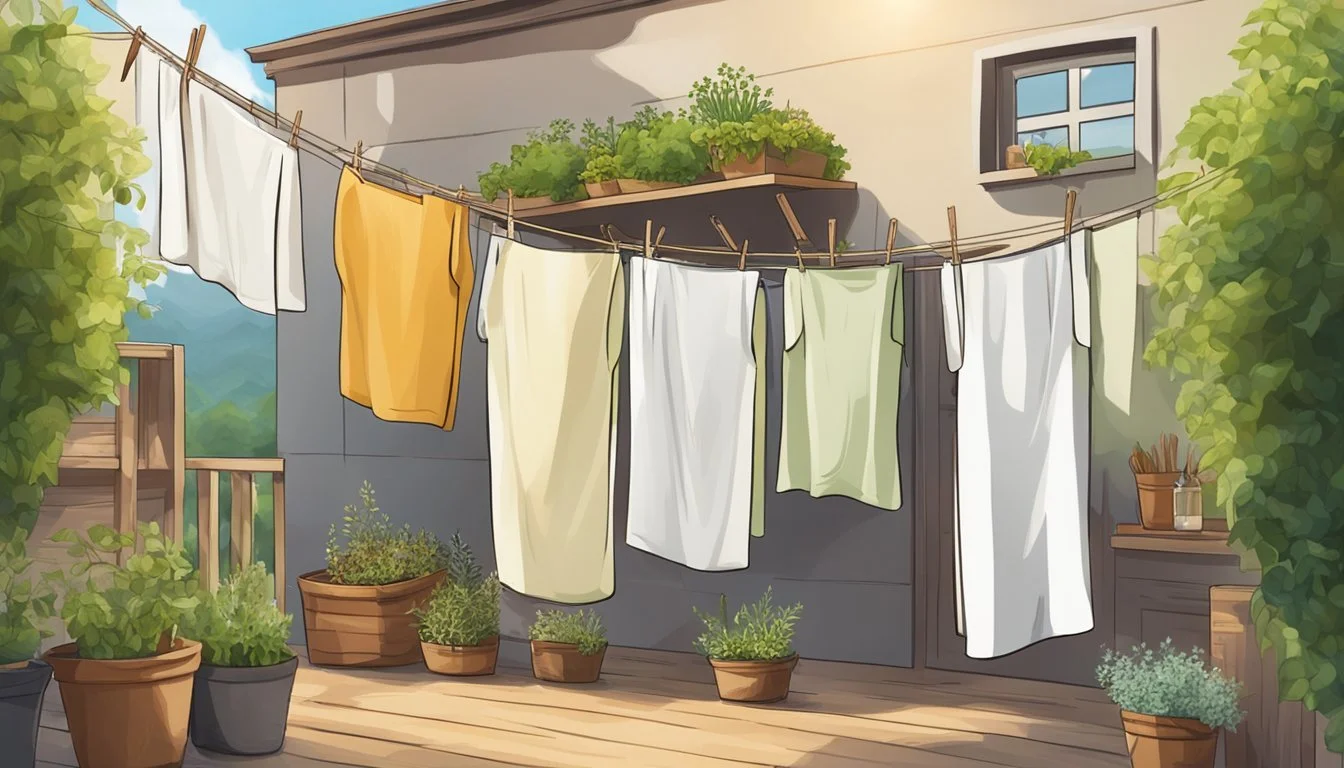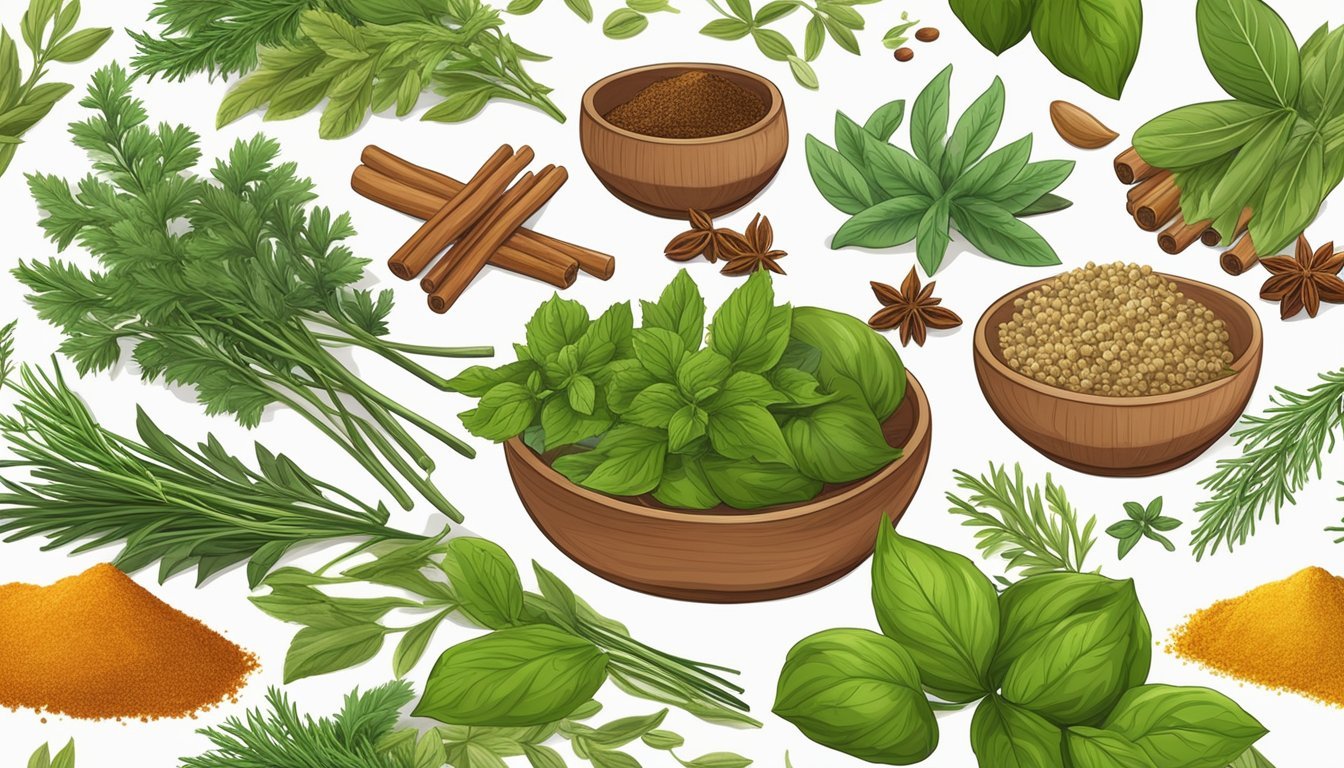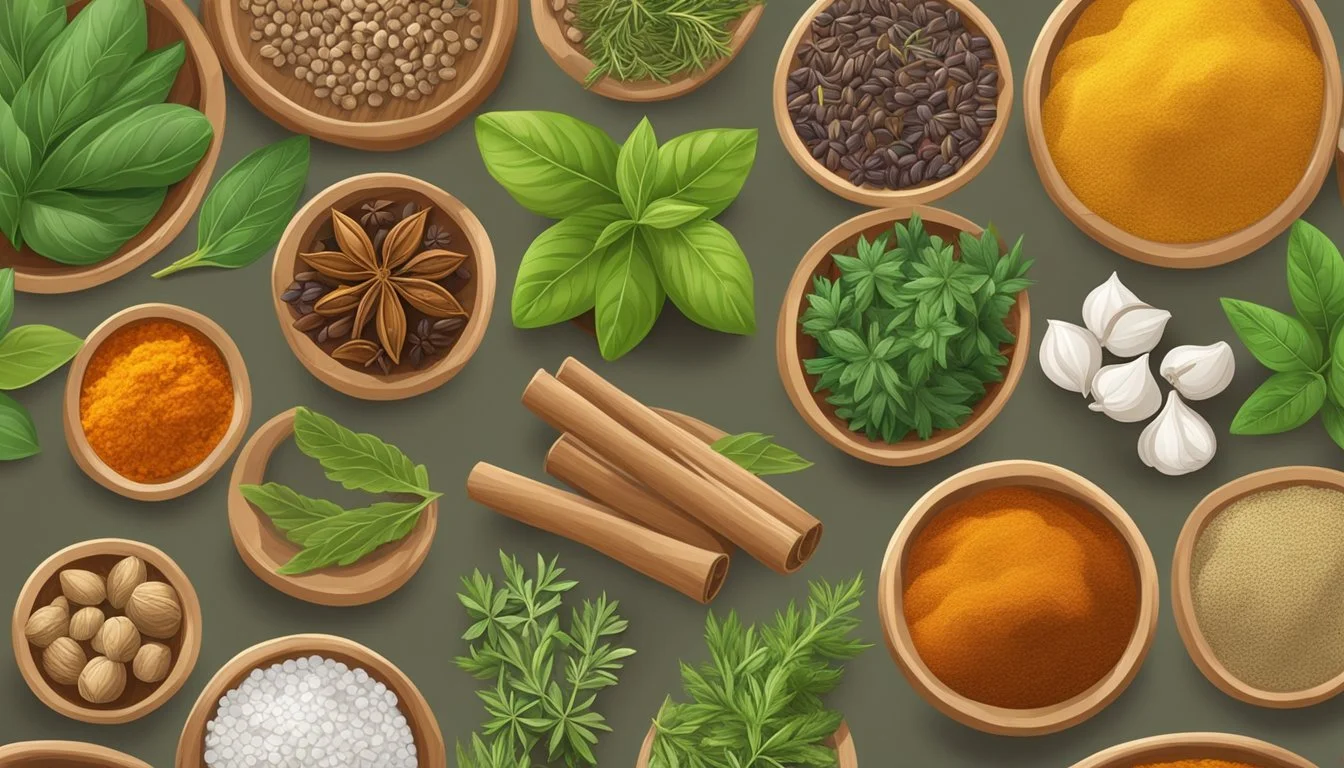The Pillowcase Drying Method
Preserve Herbs and Spices Naturally
Drying herbs is a time-honored technique that preserves the aroma and flavor of fresh herbs for use throughout the year. The pillowcase drying method offers an effective way to dry herbs and spices without the need for specialized equipment like dehydrators. This method capitalizes on the breathable fabric of pillowcases to create an ideal environment for evenly drying herbs while protecting them from dust and other contaminants.
Using a pillowcase is simple: herbs are enclosed in the fabric, which allows air to circulate around the leaves while absorbing excess moisture. As the herbs slowly dry within this makeshift cocoon, they retain their natural oils, ensuring that their flavor remains robust. This technique is particularly suited for those who prefer a passive, energy-efficient method that doesn't involve the use of electricity.
The process not only maintains the integrity of the herbs' essential oils but also prevents the loss of their vibrant color, often a challenge when using heat-based drying methods. The pillowcase method can be done at any scale, making it accessible for both casual home cooks and avid gardeners looking to preserve larger quantities of herbs.
Understanding Herb and Spice Drying Fundamentals
Drying is an essential method for preserving the flavor and extending the shelf life of herbs and spices. The process involves removing moisture, which inhibits the growth of microorganisms and prevents decay.
Key Principles:
Moisture Reduction: Removing water content secures herbs and spices against microbial decay and enzymatic reactions.
Flavor Preservation: Gentle drying methods help maintain essential oils, which are responsible for an herb's or spice's aroma and taste.
Color and Texture: Proper drying techniques can help retain the natural color and texture.
Methods of Drying:
Air-Drying: The simplest method, it requires good airflow and a dry environment.
Oven Drying: Faster than air-drying but necessitates careful temperature control to prevent burning.
Microwave Drying: Quick and effective for small batches, but requires attention to avoid overheating.
Pillowcase Drying: Involves placing herbs in a pillowcase and hanging it in a dry location, offering a protective environment that promotes airflow.
Best Practices:
Select Fresh Herbs and Spices:
Use clean, undamaged leaves and seeds
Harvest before flowering for optimal potency
Prepare Properly:
Wash thoroughly
Dry surface moisture
Drying Process:
Temperature: Keep consistent and low
Airflow: Ensure good circulation
Time: Depends on method and plant material
Remember that different herbs and spices may require varying conditions for optimal drying. Not all methods are suitable for every type, so it's advisable to experiment to find the best approach for each herb or spice.
Selecting and Preparing Herbs and Spices for Drying
Before embarking on the pillowcase drying method, one must thoughtfully select and prepare fresh herbs and spices. This lays the groundwork for preserving their flavors and aromas effectively.
Preparing Fresh Herbs
When selecting herbs from the garden or store, one should opt for those that are vibrant, with no signs of wilting or browning. Fresh herbs should be harvested right before they bloom, when their oils are at their peak for optimal flavor. To prepare them, gently wash under cool water to remove any dirt or residue. After washing, they should be patted dry or spun in a salad spinner to eliminate excess moisture, which can lead to mold growth.
Culinary herbs like basil, mint, and oregano benefit from this method as it maintains their integrity. Leave space between the leaves when laying them out, ensuring proper air circulation for uniform drying.
Which Spices to Dry
For spices, which typically refer to the dried seeds, bark, roots, or berries of plants, the drying process concentrates their flavors. One should dry spices like cinnamon bark or peppercorns that have low moisture content, to begin with, which makes them suitable for the pillowcase method.
When selecting spices to dry, they must be intact and not broken, as this can lead to a quicker loss of flavor and aroma during the drying process. Drying spices should be done whole, not ground, to maintain their potency. Once dried, these can be stored whole and ground as needed for cooking to ensure the freshest taste.
Traditional Hanging Drying Technique
The traditional hanging drying technique is a time-honored method that allows herbs to dehydrate naturally while preserving their potent flavors and medicinal properties. In this section, the focus is on setting the stage for hang drying and ensuring favorable conditions for good air circulation.
Setting Up Hang Drying
To initiate the hang drying process, one begins by gathering the herbs in small bunches. Each bunch should contain a manageable amount of stems to ensure even drying. Secure the stems together using a rubber band, which has the ability to adjust to the shrinking size of the stems as they lose moisture. It is essential to remove any damaged or diseased leaves before the herbs are hung to dry, as these can affect the quality of the final product.
Once the bunches are prepared, they are hung upside down in a dry, warm location away from direct sunlight. Ideal spots include an attic, pantry, or any indoor area with good air flow. Using hooks or nails can facilitate the hanging. Alternatively, window screens may serve as a platform for laying out the herbs; however, one should ensure they are elevated to allow air to circulate below.
Creating Good Air Circulation
Good air circulation is pivotal for drying herbs effectively. A room with natural ventilation or light air movement, away from kitchen smoke or humidity, is the most suitable environment. If necessary, a fan may be positioned to gently circulate air in the room, but it should be set on a low speed to avoid blowing the herbs around, which can lead to uneven drying or loss of leaves.
To check for proper drying, one should look for leaves that are crisp and fragile to the touch. The herbs may take several days to a few weeks to fully dry, depending on the size of the bunches, the type of herbs, and the prevailing conditions in the drying area. It's crucial that the herbs are completely dry before storage to prevent mold growth.
Oven Drying Method
Drying herbs in a conventional oven is a practical alternative for those without a dehydrator. This method is efficient in time and is conducive for culinary uses, as it helps in preserving the flavor and color of the herbs.
How to Dry Herbs in an Oven
To dry herbs using an oven, one needs to start by preheating the oven to the lowest temperature setting. Most ovens can be set to around 180°F (82°C), which is ideal for drying herbs as it minimizes the risk of burning. The herbs should be cleaned and thoroughly dried prior to oven drying. It is recommended to pat the herbs dry using a paper towel or let them air dry completely.
Once prepared, the herbs can be laid out on a baking sheet in a single layer to ensure even drying. The leaves should not overlap, as this can cause them to dry unevenly or even retain moisture, which could lead to mold.
Adjusting Temperature and Time for Optimal Drying
Oven drying is not a "set and forget" procedure. It requires regular monitoring and temperature adjustment, as needed, to ensure herbs do not burn or over-dry.
Herb Type Temperature Time Delicate Herbs 100°F - 110°F 1-2 hours Hardier Herbs 120°F - 180°F 2-4 hours
For delicate herbs, such as basil or mint, a lower temperature and shorter drying times are generally adequate. More robust herbs, like rosemary or thyme, can withstand slightly higher temperatures and longer drying times. One should check the herbs periodically and turn off the oven once the leaves crumble when pressed between the fingers, indicating they are fully dried.
The use of a regular oven for drying herbs offers a more controlled environment compared to air drying, which can be affected by varying room conditions. It should, however, be noted that a microwave is not suitable for this drying method, as it applies too much heat too quickly, which can degrade the quality of the herbs.
Alternative Drying Approaches
When considering alternatives to dehydrators for drying herbs and spices, both efficiency and careful handling are paramount to preserve flavor and quality. Key methods include microwave drying for rapid results and air drying, which utilizes ambient environmental conditions.
Using a Microwave for Quick Drying
Microwaving herbs is expedient, allowing one to dry herbs in a matter of minutes. To ensure this method is effective, one spreads the herbs on a microwave-safe plate lined with a paper towel and covers them with another paper towel. This absorbent setup helps to evenly distribute the heat and avoid moisture retention. One starts with an initial high-power burst of 60 seconds, closely monitoring to prevent burning. If herbs are not sufficiently dried, the process can be continued in 30-second intervals, constantly checking the herbs' progress.
Leveraging Air Drying on Racks
For those favoring a less intense drying method, air drying on racks is a time-honored approach. It involves spreading the separated leaves on an herb drying rack—a mesh platform that facilitates excellent air circulation—then allowing the ambient air to gently desiccate the herbs over several days to weeks. One can enhance the air drying process by wrapping the herbs in cheesecloth, which serves to protect the herbs from dust and insects while still allowing air to flow freely. Selecting a dry, well-ventilated space is crucial to the effectiveness of this method.
Packing and Storing Dried Herbs
Proper storage is crucial for maintaining the flavor and longevity of dried herbs. Selecting appropriate containers and implementing storage best practices ensures the herbs retain their quality over time.
Choosing the Right Containers
For storing dried herbs, choosing the right type of container is essential. The container must be airtight to prevent moisture from getting in and to preserve the herbs' aromatic oils. Glass jars with tight-fitting lids are typically recommended for their non-porous nature, meaning they won't retain flavors or odors from the herbs. Alternatives include metal tins with airtight lids or heavy-duty Ziploc bags if glass or metal are not available. Whichever container one opts for, it should be thoroughly clean and dry before use.
Best container options:
Glass jars with tight-sealing lids
Metal tins
Plastic bags (as a temporary solution)
Tips for Long-Term Storage
To maximize the shelf life of dried herbs, certain conditions should be maintained during storage. One should store their herbs in a cool, dark place such as a pantry or cabinet, away from direct sunlight and heat, which can expedite the loss of flavor and potency. Additionally, labeling containers with the herb's name and the date of drying will help track how long the herbs have been stored. Generally, dried herbs can last up to a year if stored correctly, though they are most potent within the first six months.
Storage guidelines:
Avoid light and heat: Store in a cool, dark environment.
Ensure airtightness: Confirm the seal of the container each time it's used.
Monitor freshness: Regularly check for any signs of moisture or decay.
Label each container: Include the herb name and the date of storage.
By adhering to the guidelines for packing and storing dried herbs, one can extend their culinary use and enjoy their flavors for months to come.
Applications in Cooking and Beyond
Drying herbs using the pillowcase method offers an accessible means to preserve their flavor and extend their shelf life. This section explores how these herbs can enhance culinary dishes and various other applications.
Incorporating Dried Herbs into Recipes
When it comes to culinary uses, dried herbs pack a concentrated flavor that is perfect for a variety of recipes. They are stellar additions in soups, stews, and marinades, where they infuse the dish with their essence during the cooking process. Chefs often create custom herb blends that can be tailored to specific cuisines, such as a mixture of basil, oregano, and thyme for Italian dishes or a combination of cilantro, cumin, and paprika for Mexican recipes.
Tips for using dried herbs in cooking:
Add early: Incorporate them at the beginning of the cooking process.
Crush lightly: To release their flavors.
Balance flavors: Use in moderation to prevent overpowering the dish.
Beyond Culinary: Other Uses for Dried Herbs
Dried herbs have applications beyond the kitchen. They're used in creating natural remedies such as salves and tinctures for skincare and medicinal purposes. These herbs serve as a foundation for aromatherapy products like sachets and potpourris, filling spaces with their therapeutic scents. Additionally, craft enthusiasts often include dried herbs in their homemade soap recipes or as decorative elements in various crafting projects.
Other uses for dried herbs:
Medicinal salves: Combine with beeswax and oils to treat skin conditions.
Aromatherapy: Used in sachets for natural scenting.
Crafting: Embed in candles or soaps for added fragrance and texture.
Maintaining Quality and Flavor
Drying herbs using the pillowcase method is an effective way to preserve their natural flavor and aroma. Ensuring fresh and organic herbs maintain their essence, it's essential they're harvested at their peak. The ideal time is just before flowering, when the oils responsible for flavor and aroma are most concentrated.
When drying herbs, it's crucial to avoid direct sunlight as it can fade color and diminish flavor. Herbs should be placed inside a pillowcase in a single layer to promote even air circulation. The pillowcase acts as a barrier against dust and other contaminants, while allowing air to flow freely. The choice of a pillowcase should be cotton or linen for its natural fibers, which are breathable and free from synthetic materials that could affect the herbs' quality.
To ensure a thorough dry without compromising the quality:
Shake the pillowcase daily to redistribute the herbs and prevent mold.
The location should be dry and warm, with ample airflow to delicately remove moisture from the herbs.
Temperature is also critical: a cool to moderately warm environment prevents the loss of essential oils, thus retaining the flavor and aroma. The herbs are sufficiently dried when they crumble easily but aren't so dry that they turn to powder.
By following these steps, one can preserve herbs effectively using a simple pillowcase, providing a natural and cost-effective alternative to electronic dehydrators without the risk of overheating or nutrient loss.
Preserving Fragile Herbs
When preserving herbs like rosemary, thyme, mint, oregano, sage, parsley, basil, tarragon, dill, and cilantro without a dehydrator, one effective method is the pillowcase drying technique. This method is suitable for delicate herbs, ensuring that their flavors and aromas are retained.
Materials Required:
Clean pillowcase
Herbs (rosemary, thyme, mint, oregano, sage, parsley, basil, tarragon, dill, cilantro)
Twine or rubber bands
Warm, dry area with good airflow
Steps to Dry Herbs in a Pillowcase:
Gather and Clean the Herbs: Begin with fresh herbs. Carefully rinse them to remove any dirt, and pat them dry with paper towels.
Prepare the Pillowcase: Ensure the pillowcase is clean to prevent any contamination.
Bundle the Herbs: Group the herbs into small bundles, tie them at the stems with twine or rubber bands.
Arrange in the Pillowcase: Gently place the herb bundles inside the pillowcase. Do not overcrowd to allow adequate airflow.
Hanging to Dry: Tie the pillowcase closed and hang it in a warm area with good air circulation. A dry attic or area with indirect sunlight is ideal.
Check the Process: Check the herbs periodically. Dehydrating might take a few days to a couple of weeks depending on the herb type and the local environment.
By using this method, the essential oils and flavors in the herbs are protected from direct sunlight, which can cause them to degrade. Herbs like basil and cilantro, which are especially fragile when dried, benefit from this gentle technique. Once fully dried, the herbs should feel crisp to the touch. Store them in airtight containers to maintain their quality for as long as possible.
Economical and Ecological Aspects of Drying at Home
Drying herbs and spices at home using a pillowcase is an approach that provides both economic and ecological benefits. Households can save money by avoiding the purchase of expensive drying equipment such as electric dehydrators. Here’s why this method makes economic sense:
Cost Savings: Utilizing a pillowcase and ambient air eliminates the need for electricity, reducing energy bills.
Maximizing Yield: Home gardeners can preserve surplus fresh and organic herbs that might otherwise go to waste.
From an ecological standpoint, drying herbs at home has a clear positive impact on the environment:
Reduced Waste: Preserving herbs in this manner reduces the need for packaging and the associated waste found in commercially dried products.
Conservation of Resources: By forgoing electronic devices, individuals conserve energy and lower their carbon footprint.
Regarding the method’s impact on quality:
Flavor Retention: When done correctly, the pillowcase drying method maintains the herbs’ potent flavors and aromas.
Organic Quality: Home drying allows complete control over the process, ensuring no chemicals or preservatives are introduced.
In summary, the pillowcase drying technique affords individuals a simple, effective means to preserve herbs. It's an economic practice that aligns with sustainable living values, reflecting a responsible choice for both the wallet and the Earth. Using materials already available in any household, one can maintain the integrity of their fresh, organic harvest.
Conclusion
Drying herbs using the pillowcase method offers gardeners and cooks a simple yet effective alternative to using a dehydrator. By leveraging this technique, one can dry herbs in a cost-effective manner without sacrificing flavor or quality. It is a low-tech process that ensures the herbs retain their potency and desired characteristics.
Steps for Success:
Preparation: Ensure herbs are clean and free from excess water.
Placement: Place herbs in a single layer within the pillowcase.
Hanging: Hang the pillowcase in a dry, well-ventilated area, away from direct sunlight.
Advantages:
Space Efficiency: The pillowcase can be easily hung, not occupying valuable countertop space.
Protection from Dust: The fabric acts as a natural barrier against dust and contaminants.
Ease of Monitoring: By simply opening the pillowcase, the progress of drying can be checked.
Using the pillowcase method, the user can maintain confidence in the preservation of their herbs' flavors and medicinal properties. The convenience of this method arises from its accessibility; one does not require specialized equipment, making it an approachable technique for all skill levels. Additionally, the method is adaptable to various environments, as long as dry conditions prevail. Consequently, this method becomes a commendable choice for those preferring an uncomplicated, yet reliable, method of herb drying.











